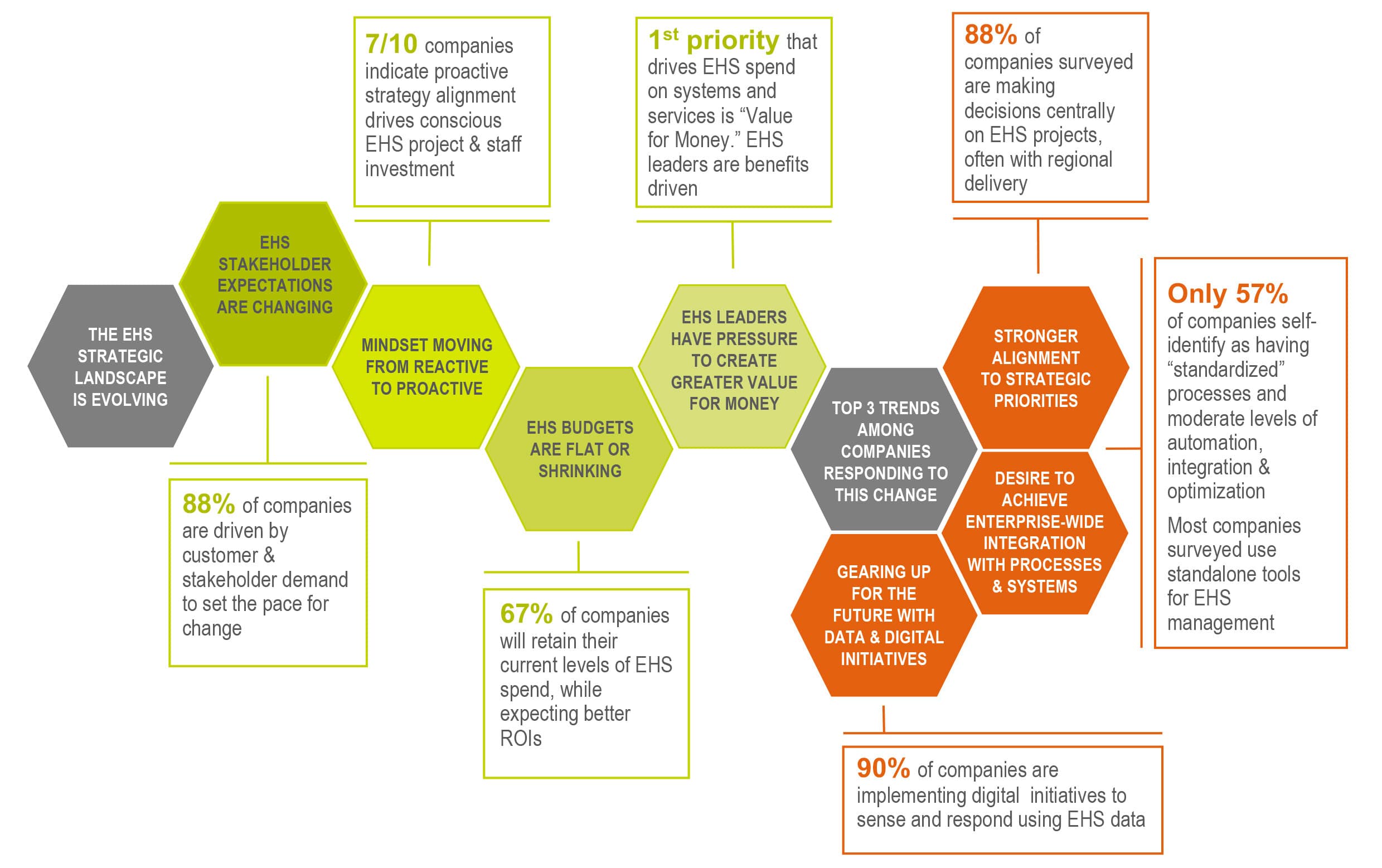A survey of 33 multinational, best-in-class organizations reveals three main themes among companies adopting a business benefits-driven mindset for EHS.
There is an emerging groundswell of change in the Environmental, Health and Safety (EHS) landscape. Companies are expected not only to improve their environmental performance but also to set the pace for change.
In an effort to shift from a reactive mindset and to better respond to stakeholders’ needs, EHS leaders are prioritizing risk management and pushing for value creation as they devise proactive corporate EHS strategies. However, the business reality is that most EHS budgets are flat or shrinking. EHS leaders are under greater pressure today to operate with a business benefits-driven mindset while guiding investment decisions in EHS staffing, structures, processes and tools.The EHS strategic landscape is also evolving. EHS champions do not want to simply improve environmental performance and reduce compliance risk for their operations — this mindset belongs to a paradigm of the past. Corporations following a business benefits-driven mindset are now strategically and proactively linking environmental, social and governance aspirations with their broader corporate mission and vision.
This paradigm is driving a new way of thinking and, subsequently, a new playbook for EHS optimization within best-in-class organizations. We engaged with 33 multinational companies in the aerospace, conglomerates, chemical and pharmaceutical, consumer goods, oil and gas, power and utilities, telecommunications, financial, and rail sectors to understand their current viewpoints on EHS — and their evolution in the spectrum of EHS maturity. Our survey found three main themes among companies aligning to this paradigm of business benefits-driven mindset:
- Stronger alignment with broader corporate strategy, increased structural alignment and support of corporate and regional operations
- A desire to achieve enterprise-wide integration of processes, systems and data
- An ambition to invest for the future through data and digital initiatives that prescriptively or proactively respond to operational or EHS indicators
Top Seven Insights from Companies Surveyed
- EHS stakeholder expectations are changing. 88 percent of companies are driven by customer and stakeholder demand to set the pace for change.
- Mindset moving from reactive to proactive. Seven out of 10 companies indicate proactive strategy alignment drives conscious EHS project and staff investment. According to the survey, there are two primary factors driving EHS investment:strategic internal initiatives and a desire to improve EHS and operational efficiency.
- EHS budgets are flat or shrinking. 67 percent of companies will retain their current levels of EHS spend while expecting better ROIs.
- EHS leaders have pressure to create greater value for money. The first priority that drives EHS spending on systems and services is “Value for Money.” EHS leaders are benefits-driven.
- Stronger alignment to strategic priorities. EHS is becoming more centralized — 88 percent of companies surveyed are making decisions centrally on EHS projects, often with regional delivery.
- Desire to achieve enterprise-wide integration with processes and systems. Only 57 percent of companies self-identify as having “standardized” processes and moderate levels of automation, integration and optimization. Most companies surveyed use standalone tools for EHS management.
- Gearing up for the future with data and digital initiatives. 90 percent of companies are implementing digital initiatives to sense and respond using EHS data.
Dive into each of these key insights by downloading our latest white paper, The Changing Paradigm: EHS Information Driven Performance.

Adjusting to the paradigm shift
This survey presents an overall positive picture for EHS. Multinational corporations are employing a proactive approach to EHS programs and taking a future-focused and integrated view of their environmental, social and governance commitments. This is mirrored in the overall emphasis their executives are placing on the importance of EHS in driving sustainable, strategic outcomes from investments. This business benefits-driven mindset approach has substantially shifted from what we’ve previously witnessed in the market, where EHS projects were planned and executed with limited strategic alignment.
However, in a changing, budget-constrained and value-oriented market, companies cannot afford to lose their license to operate or allow their environmental stewardship goals to lag. This imbalance would adversely impact sales and end-user loyalty.
Companies responding positively to the EHS paradigm shift are demonstrating stronger structural alignment to strategic priorities and a desire to achieve scaled integration with processes, systems and data. They are investing in digital initiatives to sense and respond to changing EHS stimuli, focusing on effective EHS service delivery optimization. They are also investing in enterprise-wide EHS learning, thus moving away from functional silos into better-integrated organizations for EHS optimization.
See complete survey results and analysis by downloading our latest white paper, The Changing Paradigm: EHS Information Driven Performance.








